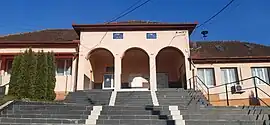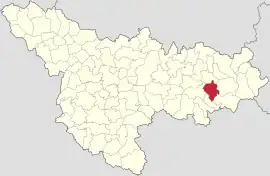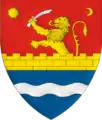Bârna
Брна | |
|---|---|
 | |
 Location in Timiș County | |
 Bârna Location in Romania | |
| Coordinates: 45°43′12″N 22°03′18″E / 45.72°N 22.055°E | |
| Country | Romania |
| County | Timiș |
| Government | |
| • Mayor (2020–2024) | Dumitru Pecora[1] (PSD) |
| Area | 78.62 km2 (30.36 sq mi) |
| Population (2021-12-01)[3] | 1,473 |
| • Density | 19/km2 (49/sq mi) |
| Time zone | EET/EEST (UTC+2/+3) |
| Postal code | 307025–307032 |
| Vehicle reg. | TM |
| Website | www |
Bârna (Hungarian: Barnafalva; Ukrainian: Брна) is a commune in Timiș County, Romania. It is composed of seven villages: Bârna (commune seat), Botești, Botinești, Drinova, Jurești, Pogănești and Sărăzani.
Geography
Located in the Săraz Valley, surrounded by forests, with villages located some on hills, others along the water, Bârna is one of the communes in the east of Timiș County and borders Fârdea to the east, Lugoj to the west, Traian Vuia to the north and Criciova and Nădrag to the south.
Bârna is crossed by several streams, the most important being Săraz, Verdea, Finodia and Scăioasa.[4]
History
The first recorded mention of Bârna dates from 1514,[5] when it belonged to the family of George of Brandenburg-Ansbach, heir of the Hunyadis. Most likely, Bârna was also owned by the Hunyadi family, as well as the other villages in the district of Bujor, as it was called then. The village was part of Timiș County, sometimes of Hunedoara County, and from the Middle Ages it was permanently inhabited. In 1771 Bârna is mentioned as belonging to the district of Făget, with 90 houses.[6] The population was predominantly Romanian. In the hearth of the village there was also the settlement of Peperig, also mentioned in 1514.
During 1970–1980, in Bârna and in the neighboring villages (Pogănești, Știuca, etc.), Ukrainians who came to work in forest exploitation and wood processing began to settle here.
Demographics
Bârna had a population of 1,640 inhabitants at the 2011 census, up 4% from the 2002 census. Most inhabitants are Romanians (69.39%), with a minority of Ukrainians (27.32%). For 3.17% of the population, ethnicity is unknown.[7] By religion, most inhabitants are Orthodox (83.05%), but there are also minorities of Adventists (8.05%), Pentecostals (3.6%) and Baptists (1.59%). For 3.23% of the population, religious affiliation is unknown.[8]
| Census[9] | Ethnic composition | ||
|---|---|---|---|
| Year | Population | Romanians | Ukrainians |
| 1880 | 2,310 | 2,271 | – |
| 1890 | 2,476 | 2,453 | – |
| 1900 | 2,862 | 2,763 | – |
| 1910 | 2,959 | 2,899 | – |
| 1920 | 2,644 | 2,621 | – |
| 1930 | 2,608 | 2,568 | 1 |
| 1941 | 2,521 | 2,485 | – |
| 1956 | 2,188 | 2,172 | – |
| 1966 | 1,882 | 1,871 | – |
| 1977 | 1,803 | 1,601 | 196 |
| 1992 | 1,691 | 1,186 | 504 |
| 2002[10] | 1,573 | 1,036 | 534 |
| 2011 | 1,640 | 1,138 | 448 |
References
- ↑ "Results of the 2020 local elections". Central Electoral Bureau. Retrieved 16 June 2021.
- ↑ "Primăria Bârna". Ghidul Primăriilor.
- ↑ "Populaţia rezidentă după grupa de vârstă, pe județe și municipii, orașe, comune, la 1 decembrie 2021" (XLS). National Institute of Statistics.
- ↑ "Comuna Bârna". Portalul comunelor.
- ↑ Szabó, M. Attila (2003). Erdély, Bánság és Partium történeti és közigazgatási helységnévtára. Miercurea Ciuc: Pro-Print Kiadó.
- ↑ "Fișa Primăriei comunei Bârna pe anul 2013". Consiliul Județean Timiș.
- 1 2 "Tab8. Populația stabilă după etnie – județe, municipii, orașe, comune". Institutul Național de Statistică. Archived from the original on 2016-01-18. Retrieved 2021-09-04.
- 1 2 "Tab13. Populația stabilă după religie – județe, municipii, orașe, comune". Institutul Național de Statistică. Archived from the original on 2020-08-07. Retrieved 2021-09-04.
- ↑ Varga, E. Árpád. "Temes megye településeinek etnikai (anyanyelvi/nemzetiségi) adatai 1880-1992" (PDF).
- ↑ "Bârna / Barnafalva". Structura etno-demografică a României. Centrul de Resurse pentru Diversitate Etnoculturală.
